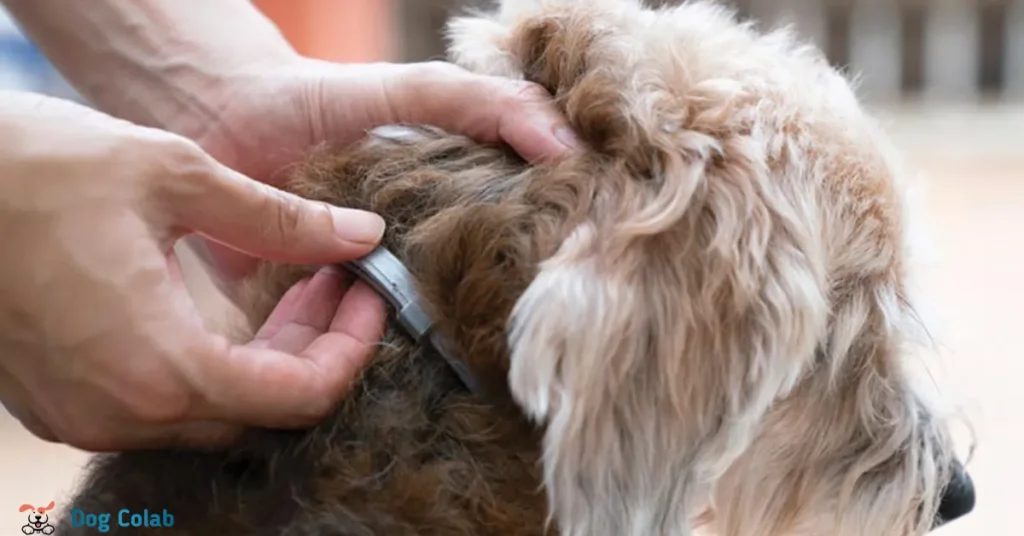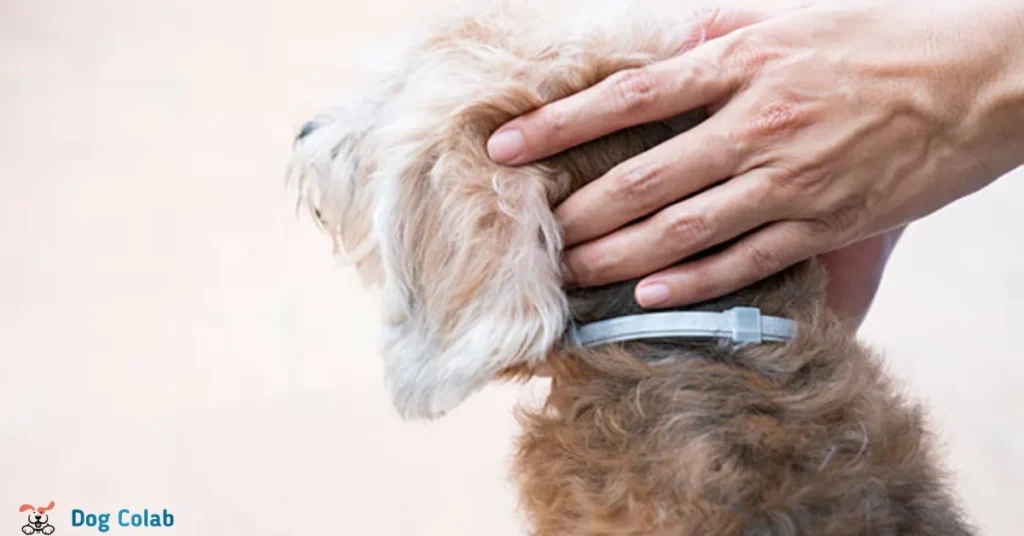Pet owners often prioritize the well-being of their furry companions, seeking ways to protect them from pests like fleas and ticks. One popular option is the Seresto collar, known for its long-lasting effectiveness against these parasites.
However, there’s a possibility that some dogs might experience allergic reactions to the collar’s ingredients.
According to Dr. Coates, Seresto collars can cause allergic reactions in dogs, and she advises pet owners to monitor their dogs closely for symptoms. She recommends removing a dog’s collar immediately if they suspect their dog is allergic to it.
In this blog post, we will discuss the possibility of whether or not can my dog be allergic to the seresto collar, examining symptoms, causes, and possible solutions.
How Do Seresto Collars Work?
Fleas, ticks, and other parasites can cause significant discomfort and health issues for dogs. To combat these pests, pet owners often turn to various preventive measures, including collars. One such collar, the Seresto collar, has gained popularity for its long-lasting protection against fleas and ticks.

The Seresto collar is a type of flea and tick collar designed to provide continuous protection against these parasites for an extended period, usually around 8 months. What sets Seresto collars apart is their innovative design and the active ingredients they contain.
What Is the Active Ingredient In Seresto Collar?
A Seresto collar contains two active ingredients: imidacloprid and flumethrin. These compounds work together to effectively repel and eliminate fleas, ticks, and lice from your dog’s coat.
Imidacloprid: This ingredient is part of a class of chemicals known as neonicotinoids, which target the nervous systems of insects. Imidacloprid disrupts the normal functioning of insect nerve cells, leading to paralysis and eventual death. It primarily targets fleas, preventing them from infesting your pet.
Flumethrin: Flumethrin is a synthetic pyrethroid, a type of insecticide commonly used to control ticks and other pests. It works by interfering with the nervous system of insects, causing paralysis and death. Flumethrin’s effectiveness against ticks makes it a valuable component of the Seresto collar.
Matrix Technology
One of the key features of the Seresto collar is its matrix technology, which allows for the controlled and sustained release of the active ingredients. The collar’s matrix is a specialized polymer that holds imidacloprid and flumethrin within its structure. Over time, these ingredients are slowly released onto the dog’s skin and coat.
How Does the Collar Work?
When the Seresto collar is worn around your dog’s neck, the friction and movement of the collar against the fur cause the active ingredients to migrate onto the skin and hair.
This provides a layer of protection that repels and kills fleas, ticks, and lice as they come into contact with the treated fur. The collar doesn’t require the pests to bite or attach to the dog to be effective; the repelling action helps prevent infestations.
Can My Dog Be Allergic To the Seresto Collar?
Yes, the Seresto collar can cause an allergic reaction in dogs. Just like humans can develop allergies to certain substances, dogs can also experience allergic reactions to various materials, chemicals, or compounds.

The Seresto collar contains active ingredients, imidacloprid, and flumethrin, that are gradually released to repel and kill fleas, ticks, and lice. While most dogs tolerate the collar without any issues, some dogs experience allergic reactions to it.
Read more:- Dog Breaking his collar.
Causes of Allergic Reactions In Dogs To Seresto Collar
Allergic reactions in dogs to Seresto collars can arise from various factors, primarily centered around the active ingredients, design, and individual sensitivities.

1. Active Ingredients
The active ingredients in Seresto collars, imidacloprid, and flumethrin, can trigger allergic responses in some dogs. Just as humans can be sensitive to certain substances, dogs may react adversely to these chemicals, leading to skin irritation, itching, redness, and other symptoms.
2. Material Sensitivity
Some dogs might develop allergies to the materials used in the collar, such as the polymer matrix or the adhesive that holds the collar together. Direct contact between these materials and the skin can lead to allergic reactions.
3. Friction and Pressure
The collar’s design and its snug fit can cause friction and pressure against the skin, potentially leading to irritation, hair loss, or discomfort. Dogs with sensitive skin might be more prone to such reactions.

4. Individual Variability
Just like humans, dogs have varying immune responses. What triggers an allergic reaction in one dog might not affect another. Dogs with a history of allergies or sensitivities could be more susceptible to reacting to the collar.
5. Combined Effects
In some cases, it could be a combination of factors that contribute to the allergic reaction. A dog’s individual sensitivity, coupled with direct contact with the active ingredients or collar materials, could intensify the allergic response.
6. Incorrect Usage
Allergic reactions can also result from improper usage of the collar, such as the collar fitting too tightly or not adjusting it properly. This could increase friction, pressure, and irritation on the skin.
What Are the Side Effects of Seresto Flea Collar?
Like any medication or product, there is a possibility of seresto dog collar side effects or adverse reactions. Some reported seresto collar side effects and considerations associated include.

- Skin Irritation: Some pets may experience mild skin irritation or redness around the area where the collar is worn. This can manifest as itching, scratching, or discomfort.
- Hair Loss: In certain cases, pets might exhibit hair loss or thinning of fur around the collar area. This could be due to irritation or friction caused by the collar.
- Allergic Reactions: A small percentage of pets could potentially develop allergic reactions to the active ingredients (imidacloprid and flumethrin) or the materials used in the collar. These reactions could include redness, swelling, hives, or more severe symptoms.
- Gastrointestinal Upset: While uncommon, some pets might ingest small amounts of the collar’s ingredients while grooming themselves. This could potentially lead to gastrointestinal upset, such as vomiting or diarrhea.
- Behavioral Changes: A few pet owners have reported behavioral changes in their pets, including lethargy or changes in appetite. However, it’s important to consider other factors that could be contributing to these changes.
- Neurological Symptoms: In very rare cases, pets may exhibit neurological symptoms, such as tremors or seizures. If such symptoms occur, immediate veterinary attention is necessary.
Read More:- Get rid of dog collar marks.
Signs of Allergic Reactions In Dogs
Allergic reactions in dogs can manifest in various ways, and the signs can range from mild to severe. Here are some common signs of allergic reactions in dogs.

- Skin Irritation: Redness, inflammation, or rash on the skin, often accompanied by itching or scratching.
- Itching and Scratching: Excessive scratching, licking, or chewing of certain body parts, particularly the paws, ears, face, and belly.
- Hives (Urticaria): Raised, swollen bumps on the skin that may be red or pale in color and can cause discomfort.
- Swelling: Facial swelling, especially around the eyes, muzzle, or ears, can be a sign of an allergic reaction.
- Hair Loss: Allergic reactions can lead to hair loss, thinning of fur, or bald patches, especially in the areas where your dog is scratching or biting.
- Watery Eyes and Runny Nose: Dogs might exhibit symptoms similar to humans with allergies, including watery eyes, sneezing, and a runny nose.
- Gastrointestinal Upset: Vomiting, diarrhea, or changes in appetite could indicate an allergic reaction, particularly if the allergen was ingested.
- Respiratory Distress: Wheezing, coughing, or difficulty breathing could occur in severe cases of allergic reactions.
- Lethargy: A sudden decrease in energy levels or overall lethargy might be a sign that something is amiss.
- Paw Chewing and Licking: Persistent chewing, licking, or biting at the paws could be indicative of allergies, especially if the paws are red, inflamed, or irritated.
- Ear Infections: Recurrent ear infections or ear inflammation could be a sign of allergies, especially in dogs with sensitive ears.
- Rubbing Against Objects: Dogs might rub their bodies against furniture, walls, or the floor to alleviate itching or discomfort.
What To Do If Shows Signs of Allergic Reactions In Dogs?
If your dog shows signs of allergic reactions, it’s essential to take prompt action. First, remove the Seresto collar immediately. If you suspect the collar is the cause, take it off your dog and dispose of it properly. Next, contact your veterinarian for guidance. Describe the symptoms and provide information about the collar usage.

Your vet will advise you on the best course of action, which might include recommending antihistamines or other medications to alleviate symptoms. In severe cases, your vet might want to examine your dog to rule out any underlying issues and provide more targeted treatment.
Keep a close eye on your dog’s condition, and follow your vet’s recommendations to ensure your pet’s comfort and well-being.
Recommended Also Read:- How long does a dog take to get used to a collar.
Are Seresto Collars Safe For Humans To Touch?
Seresto collars are designed to be safe for pets when used as directed. However, it’s advisable to minimize direct contact with the collar for humans, especially prolonged or repeated contact, as a precaution.

The collar ingredients are formulated to target parasites, they are generally considered safe for pets when used as directed. However, prolonged or direct contact with the collar might lead to skin irritation or discomfort for humans, especially those with sensitive skin or allergies.
When handling a Seresto collar, it’s a good practice to wash your hands thoroughly afterward to reduce the likelihood of any residue coming into contact with your skin. Additionally, avoid touching your face or eyes while handling the collar, and keep the collar out of reach of children.
What Kills Fleas on Dogs Instantly Naturally?
While there isn’t a completely natural method that will instantly kill fleas on dogs, there are several natural remedies that can help manage and reduce flea infestations over time. But it is important to note natural remedies may take time to show results and might not be as instantly effective as some chemical treatments. Here are some options to consider for killing fleas and dogs naturally.
1. Diatomaceous Earth
Food-grade diatomaceous earth, made from fossilized algae, can be sprinkled on your dog’s fur and bedding. It has microscopic sharp edges that can help dehydrate and kill fleas over time. Be cautious not to inhale the dust, and ensure your pet doesn’t ingest it.
2. Essential Oils
Some essential oils like lavender, cedarwood, and eucalyptus have natural flea-repelling properties. It is important, however, to use them properly and with caution. Dilute the essential oils and apply them sparingly, as some dogs can be sensitive or have adverse reactions.

3. Herbal Baths
Herbal baths using ingredients like rosemary, chamomile, or pennyroyal can help repel fleas. However, consult your veterinarian before using any herbs on your dog, as some can be toxic in larger quantities.
4. Regular Grooming
Frequent and thorough grooming with a flea comb can help physically remove fleas from your dog’s coat. Have a bowl of soapy water nearby to drown any fleas you comb out.
5. Wash Bedding
Wash your dog’s bedding and blankets regularly in hot water to kill any fleas and eggs.
Conclusion “Can My Dog Be Allergic To the Seresto Collar”
While the Seresto collar is generally effective in protecting dogs against fleas, ticks, and lice, it’s possible for some dogs to develop allergic reactions to its active ingredients or materials. Pet owners should be vigilant in monitoring their dogs for any signs of discomfort, skin irritation, or unusual behavior after using the collar.
If such symptoms arise, promptly removing the collar and seeking veterinary advice is crucial to ensure the well-being of the pet.
NOTE:- More information can be found by clicking this link.
FAQs
1. Are Seresto collars dangerous for dogs?
Seresto collars are generally safe for dogs when used as directed. However, some dogs might experience allergic reactions or discomfort.
2. Can Seresto collar cause itching?
Yes, some pets may experience itching or skin irritation as a possible side effect of wearing a Seresto collar, although not all pets will have this reaction.
3. Do Seresto collars cause rashes?
Yes, some pets may experience itching or skin irritation as a possible side effect of wearing a Seresto collar, although not all pets will have this reaction.
4. Can Seresto collar make dogs sick?
In rare cases, Seresto collars may cause mild skin irritation or digestive upset in dogs. Monitor your pet for any adverse reactions and consult a vet if concerned.
5. How long do you leave Seresto collar on?
The Seresto collar is typically worn continuously and replaced every 8 months for optimal flea and tick protection for your pet.

